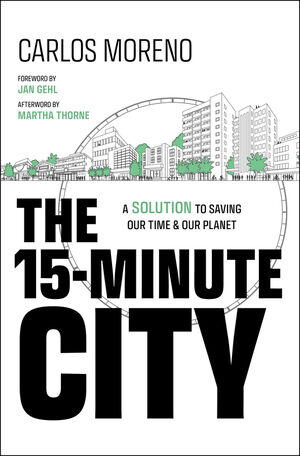 |
| Chuck Marohn isn't freaking out. Maybe I shouldn't either? (Source: strongtowns.org) |
NOTE: In the innocent days of the last decade, my Corridor Urbanism co-founder Ben Kaplan did a series of what he called Urbanist Goodreads, annotated bibliographies of writing on a particular topic. I dabbled in the format myself to analyze the impact of COVID on the future of cities; here's an example from June 2020. Now, with a runaway U.S. executive breaking the government for the purpose of retribution (Donald Trump) and/or amassing money and power (Elon Musk) and/or an ideological vision (the Project 2025 crew), and states like Iowa micromanaging localities whenever they feel like it, what is left for urbanism to think about? Quite a bit, it appears.
"Growth Ponzi Scheme Leaves Virginia Town with $34 Million Dilemma," Strong Towns, 6 February 2025
[Strong Towns grew out of planner-engineer Chuck Marohn's doubts about the rationality of some of the projects he was being hired to do. His doubts became a blog and podcast, which became an organization, which has become a movement with chapters ("local conversations") all over the world. Marohn spoke in Iowa City in July 2015.]
Strong Towns takes us this week to Purcellville, Virginia, a small town near the border with West Virginia, but not terribly far from Washington, D.C. The story reflects a theme that has been prominent throughout Strong Towns' decade-plus existence: a town can't afford to maintain infrastructure it had built when it was hopeful about growth. "I'm just saying the funds were there when the town was growing like crazy," says Liz Krens, the town's Director of Finance. Like a Greek tragedy, none of their current choices--borrow $34 million? defer maintenance?--is good. Maybe a federal grant would solve their problems, but counting on that is not responsible.
This week's Strong Towns posts also address the limitations of traffic cameras and a local group in Maine that resisted the state's plan to widen a highway through their town.
Robert Steuteville, "Hurricane-Ravaged City Bounces Back with New Main Street," Public Square: A CNU Journal, 4 February 2025
[Public Square is the online journal of the Congress for the New Urbanism, which has been promoting a return to compact, mixed-use development since they gathered in Alexandria, Virginia, in 1993. Their most recent conference was last May in Cincinnati. CNU's membership includes planners, architects, and local officials; I am none of these, but they let me in anyway.]
The lead story this week celebrates the recovery of Panama City, Florida, which won a Charter Award at the 2020 conference, following Hurricane Michael in 2018. The award-winning plan is now being enacted, centered on a restored Harrison Street, which has again become the heart of the city. With better design, street trees and slower vehicle traffic, along with a new central plaza, the core of the city has been restored to life. “There’s a growing collection of wedding photos on the circle on Harrison Avenue,” crowed lead designer Victor Dover. “No one was getting a wedding photo on the main street before.” Note that implementation was expedited by federal COVID relief funds.
Other current Public Square stories include an urban boulevard replacing a freeway in Toledo, proposed mall redevelopment in Michigan, and a foundation specializing in wildfire recovery, as well as a post arguing for attention to housing supply and affordability in "15-minute city" projects.
Addison del Maestro, "I'm an Antisocial Urbanist Living in the Suburbs, Ask Me Anything," The Deleted Scenes, 4 February 2025
[Addison del Maestro writes about design and a whole bunch of other stuff from his base in suburban Virginia. He's Catholic by faith and conservative by politics, which makes for unique takes on urbanist issues.]
This reflective post starts with the irony that del Maestro identifies as an urbanist while living in a suburban community. "I’m not quite sure," he confesses, "how these abstract ideas I hold about housing and community and not putting up walls around places and not being exclusionary intersect with living in an actual place with actual characteristics with actual people who were “buying” those characteristics when they bought homes here." It's gotten to the point where he feels like arguing with visitors who admire his neighborhood! I can relate, doing my urbanist writing in a large-lot neighborhood with no commercial establishments for blocks. How much change can he (or I) advocate when most of our neighbors presumably prefer the current characteristics?
This week, del Maestro's wide-ranging blog also covers reuse of old buildings, eccentric product design, and materialism, as well as his own set of goodreads.
 |
| In 2018 I would take the Silver Line to McLean for 1 Million Cups Fairfax |
Ryan Jones, "Commuter Rail to Loudoun: The Next Chapter," Greater Greater Washington, 7 February 2025
[Greater Greater Washington is a website with an urbanist mission: "racial, economic, and environmental justice in land use, transportation, and housing." They focus on the D.C. area (which extends to Baltimore and sometimes Richmond). I've been personally very attached to Washington since my semester there seven years ago.]
Jones tells the story of founding a group to promote extension of metro Washington commuter rail service westward into the Virginia suburbs (maybe as far as Purcellville!). He discusses budgeting, positive effect on road traffic, and advantages over building out the Silver (Metro) Line. Their next steps is to speak to town councils in the region. "By building a consensus town by town, we hope to gain momentum to get an official feasibility study commissioned by Loudoun and Fairfax counties in partnership with state and regional agencies..."
Besides opinion posts, Greater Greater Washington also includes their "Breakfast Links" collection of local goodreads, urbanist news from other parts of the country (including a bicycling promotion program in Denver) and opportunities to get involved around the DC area.
Pete Saunders, "Why Call It 'The Rust Belt?'" The Corner Side Yard, 2 February 2025
[Pete Saunders is from Detroit, and now lives in Chicago. He is an important Midwestern voice in a movement that can overfocus on the fast-growing towns on the coasts. His attention to black and working class experiences of cities make his voice especially valuable.]
This piece is less about policy than about nomenclature. Sanders embraces rather than resents the term Rust Belt for what was once the industrial Midwest (think Chicago, Milwaukee, Detroit, Cleveland and all those little cities in eastern Ohio, maybe Pittsburgh). It can symbolize what it could be, "a term roughly synonymous with the legend of the phoenix, the mythological bird that rises from the ashes of its deceased predecessor." Like London, which emptied out after the Romans left in the fifth century but in time became one of the leading cities of the world, the Rust Belt (or Lower Lakes, if you prefer) can rise from its knees and become something else entirely.
 |
| Stacy Mitchell's book |
And there's more!
- Stacy Mitchell of the Institute for Local Self-Reliance was quoted extensively in a Washington Post article on the reslient role of small businesses in the American economy, despite apathy (at best) from national elected officials. (Did you know local restaurants now last slightly longer than the average small business start?)
- The Active Towns podcast, hosted by John Simmerman, presents a video on a "bike bus" in Montclair Township, New Jersey.
- Happy Cities reports on a survey in Seattle finding "a remarkable relationship between street edges, building facades and pro-social behavior," suggesting a role for city design in human sociability.
- Kristen Jeffers's latest salutes Rev. Andrew Wilkes, a pastor in Brooklyn who shows the influence of faith on urban issues like gentrification.
- Planetizen reports the California High-Speed Rail Authority anticipates running trains between coastal cities and the Central Valley in five to eight years.
So there ya have it--urbanists are thinking about urban stuff: infrastructure and how to pay for it, rebuilding downtown, small business, public transit, cycling, trains, and shaping values which I guess includes branding. None of them even referenced national political dysfunction.
Friends, it does my soul good to think about all these people thinking about how to improve their places. It takes considerable nimbleness to negotiate around personal differences, not to mention state and national interference. I hope that what doesn't kill us will in time make us strong. But I'm still concerned that conditions for building prosperous, resilient and inclusive communities are becoming harder each day. Keep the faith, I guess.






























